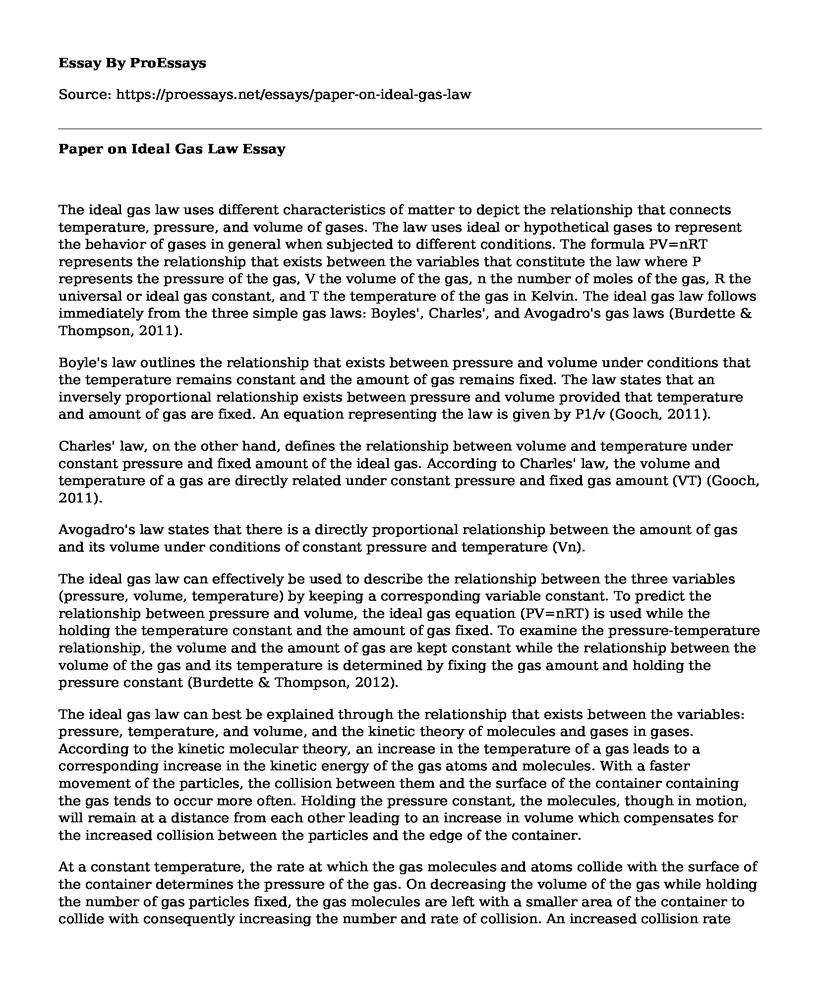The ideal gas law uses different characteristics of matter to depict the relationship that connects temperature, pressure, and volume of gases. The law uses ideal or hypothetical gases to represent the behavior of gases in general when subjected to different conditions. The formula PV=nRT represents the relationship that exists between the variables that constitute the law where P represents the pressure of the gas, V the volume of the gas, n the number of moles of the gas, R the universal or ideal gas constant, and T the temperature of the gas in Kelvin. The ideal gas law follows immediately from the three simple gas laws: Boyles', Charles', and Avogadro's gas laws (Burdette & Thompson, 2011).
Boyle's law outlines the relationship that exists between pressure and volume under conditions that the temperature remains constant and the amount of gas remains fixed. The law states that an inversely proportional relationship exists between pressure and volume provided that temperature and amount of gas are fixed. An equation representing the law is given by P1/v (Gooch, 2011).
Charles' law, on the other hand, defines the relationship between volume and temperature under constant pressure and fixed amount of the ideal gas. According to Charles' law, the volume and temperature of a gas are directly related under constant pressure and fixed gas amount (VT) (Gooch, 2011).
Avogadro's law states that there is a directly proportional relationship between the amount of gas and its volume under conditions of constant pressure and temperature (Vn).
The ideal gas law can effectively be used to describe the relationship between the three variables (pressure, volume, temperature) by keeping a corresponding variable constant. To predict the relationship between pressure and volume, the ideal gas equation (PV=nRT) is used while the holding the temperature constant and the amount of gas fixed. To examine the pressure-temperature relationship, the volume and the amount of gas are kept constant while the relationship between the volume of the gas and its temperature is determined by fixing the gas amount and holding the pressure constant (Burdette & Thompson, 2012).
The ideal gas law can best be explained through the relationship that exists between the variables: pressure, temperature, and volume, and the kinetic theory of molecules and gases in gases. According to the kinetic molecular theory, an increase in the temperature of a gas leads to a corresponding increase in the kinetic energy of the gas atoms and molecules. With a faster movement of the particles, the collision between them and the surface of the container containing the gas tends to occur more often. Holding the pressure constant, the molecules, though in motion, will remain at a distance from each other leading to an increase in volume which compensates for the increased collision between the particles and the edge of the container.
At a constant temperature, the rate at which the gas molecules and atoms collide with the surface of the container determines the pressure of the gas. On decreasing the volume of the gas while holding the number of gas particles fixed, the gas molecules are left with a smaller area of the container to collide with consequently increasing the number and rate of collision. An increased collision rate results in increased pressure (Gooch, 2011).
Dalton's law of partial pressures states that given a mixture of gases, the total pressure exerted by the mixture equals the sum of individual gases' partial pressures. Graham's law of diffusion, on the other hand, states that the effusion or diffusion rate of a gas is inversely proportional to the square root of the weight of the gas molecules.
Dalton's law is applied in operating fire extinguishers and scuba divers' safety. In a fire extinguisher, there is a head space left at the top of the extinguisher as the water and the CO2 do not fully fill the container. On activating the operating lever, the spring mechanism is activated piercing the valve at the top making the CO2 fill out in the space. The CO2 released exerts pressure on the water causing the mixture of the two to rush out of the siphon. Scuba divers use a mixture of oxygen and helium during deep sea diving since normal air mixture would prove disastrous if inhaled at such depths. Helium does not dissolve in human blood while oxygen operates under Dalton's law of partial pressures by exerting the same pressure that it would have even if it were in the normal air mixture (Bahl, Bahl, & Tuli, 2012).
Graham's law of diffusion is applied in the separation of different gases that have different densities. In research, Graham's law uses the different diffusion rates of gases to determine their molecular masses and densities and separation of isotopic elements (Bahl et. la, 2012).
The three gas laws: Boyle's, Charles', and Avogadro's, therefore, form a critical part of the ideal gas laws and their relationship can easily be defined almost directly from the Ideal gas laws. Dalton's and Graham's laws also play a pivotal role as far as gas laws are concerned helping to make some principles of the ideal gas laws easier to comprehend.
References
Bahl, A., Bahl, B. S., & Tuli, G. D. (2012). Essentials of physical chemistry. S. Chand.
Burdette, D., & Thompson, T. R. (2012). Ideal Gas Law.
Gooch, J. W. (2011). Ideal-gas law. Encyclopedic Dictionary of Polymers, 381-381.
Cite this page
Paper on Ideal Gas Law. (2021, Apr 08). Retrieved from https://proessays.net/essays/paper-on-ideal-gas-law
If you are the original author of this essay and no longer wish to have it published on the ProEssays website, please click below to request its removal:
- Coal Mining in Appalachia
- Compare and Contrast Essay Example: the Moon and Mars
- National Geographic: The Photographic Vision Essay Example
- Keplers Law - Essay Sample
- Chemical Risks in Nursing: Navigating Hazards for Oncology Nurses - Essay Sample
- Shenzhen: Landscape, Flora, Fauna & Geology - Essay Sample
- Mass Spectrometry for Determining Substance Concentrations in Individuals - Essay Sample







